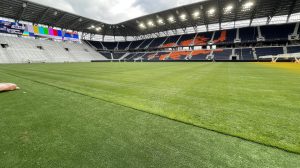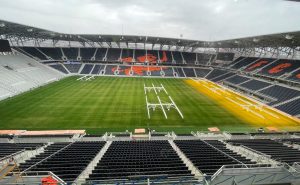After Three MLS Seasons, FC Cincinnati Gets Permanent Home in New TQL Stadium
The club tapped Alpha Video to do systems integration
Story Highlights
A year after its 25th anniversary, Major League Soccer is embarking on a golden age of venue design with three new builds across the nation. The first of the trio, FC Cincinnati’s TQL Stadium, will open in 3½ weeks when Inter Miami comes to visit on Sunday, May 16. The club’s first fully dedicated stadium will include the league’s largest videoboard in a soccer-specific venue, 1080p HDR workflows, and control-room technology installed by Alpha Video.
Homage to Allianz: Minnesota Venue Provides Structural, Logistical Roadmap

After three seasons at Nippert Stadium, TQL Stadium will be FC Cincinnati’s first official home. (Photo: Tom Gelehrter/@Tommy_G on Twitter
In its first two MLS seasons, FC Cincinnati hosted home matches in the University of Cincinnati’s Nippert Stadium, a little more than 2 miles north of TQL Stadium. The collegiate-football venue provided ample space for supporters to cheer on their squad, but, as with other franchises playing matches in shared buildings — Nashville SC in the Tennessee Titans’ Nissan Stadium, NYFC in Yankee Stadium — there was something missing. To establish its own foothold in the city, the club moved forward with the construction of a stadium that would reflect their unique identity.
“FC Cincinnati had an amazing atmosphere with an extremely passionate fan base, but it’s going to be amazing when they enter this facility for the first time,” says Jeff Volk, VP, Alpha Video. “It has been super fun and rewarding to work with a team and build a stadium and environment of their own.”
For the new structure, the FC Cincinnati ownership group wanted to emulate the closed-canopy roof and exterior look of Bayern Munich’s Allianz Arena in Germany. A U.S. stadium with a similar name, Allianz Field in St. Paul, MN, served as inspiration on the technological side. Minnesota-based Alpha Video supplied system integration for Minnesota United FC in 2019. For this project, Gameday Technologies powered by Atomic Data, a company that represents FC Cincinnati’s venue endeavors, chose Alpha Video to implement similar workflows.
“The control-room technology is very similar to what we did at Allianz Field,” notes Volk. “When Allianz Field opened, it set the bar from a game-presentation perspective, and, since there was a strong familiarity with Atomic Data, the goal was to replicate many of those same elements.”
On the physical side of the project, Alpha Video were able to work under clearer conditions after completing projects, such as the Las Vegas Raiders’ Allegiant Stadium and Intermountain Healthcare Performance Center, during the early stages of the pandemic. With obstacles posed by COVID-19 out of the way, the final product was developed through constant collaboration between the club’s control-room staff and the workers doing the job onsite.
“We certainly [saw] less of an impact than with projects that were done last summer,” says Volk. “Back in May, June, and July, everyone was figuring things out on the fly. We mobilized onsite in Cincinnati in November and December. By that point, everyone involved hit their stride in terms of COVID-19 preparedness and understanding what we needed to do logistically to work within safety regulations.”
All in the Tech: Control Room Has 1080p HDR Capabilities, Large Ross Video Presence

The control room in the 26,000-seat stadium will have 1080p HDR capabilities. (Photo: Tom Gelehrter/@Tommy_G on Twitter)
In the new control room, the club’s in-venue staff will work with high-level equipment and workflows. Ross Video will play a large role in each production, providing a 2M/E Carbonite Ultra switcher with TouchDrive on the front bench, an Ultrix router, and XPression graphics with Inception social-media management. Other notable technologies include Evertz DreamCatcher as the in-stadium replay anchor and Riedel’s Artist and Bolero handling wired and wireless communications, respectively.
In other parts of the control room, the tech will feature test and measurement devices supplied by Leader; video monitors from Sony, Ikegami, and Marshall Electronics; recording captured by AJA Ki-Pro Ultra Plus and Ki-Pro GO; and KVM by Adder Technology.
In the stadium’s lower bowl, the production team will have a handful of cameras at their disposal, including four Sony HXC-FB80 hard cameras and a wireless Sony HXC-FB80 with RF coverage from Wave Central. The cameras will be outfitted with five types of Canon lenses: three at 80X, one at 24X, and one at 14X.
Around the Pitch: Videoboard in The Bailey, IPTV System To Heighten Game-Day Experience
Night matches in Cincinnati will be a lot brighter with TQL Stadium’s LED real estate. The 26,000-seat venue has two major LED installations on both the building’s interior and exterior. From the outside, passers-by will be able to tell who’s playing, thanks to a stunning LED system that can be coordinated with music on the stadium’s façade. It’s a fixture that is seen in Las Vegas and Minnesota as well:
Inside the venue, the north side will be home to the league’s largest LED display for a soccer-specific stadium. With its wide structure, it will serve as a backdrop for The Bailey, the stands that will house the raucous supporters’ section. Installed by Daktronics, the videoboard will offer images and video in HDR:
The @WestEndStadium is ready to rock. #TheBailey #MLS #FCCincy pic.twitter.com/D8Fn3jOpg0
— Taylor Twellman (@TaylorTwellman) March 19, 2021
As fans make their anticipated return to the stands, they’ll be able to stay up-to-date with the action on the pitch via VITEC’s EZTV IPTV system and MGW and MGES encoders.
Jewel in the Queen City: Alpha Video Creates the Club’s In-Venue Future
By the time the doors officially open in mid May, it will have been more than a year and a half since the club’s last home game with fans, on Sept. 29, 2019. It’s a long-overdue moment when fans can come together and celebrate a new chapter of the city’s sports history. When the first whistle blows, it’ll mark the league’s continuing commitment to making the game experience as immersive as possible.
“MLS has raised the bar since the initial launch of stadiums that had basic control rooms and systems,” says Volk. “As the league surges in popularity, teams are making an investment in the game-presentation side.”
TQL Stadium will host a total of 17 home matches during the MLS regular season, including high-profile outings against defending champion Columbus Crew on July 7, MLS Is Back Tournament runner-up Orlando City SC on Aug. 7 and Oct. 16, and the finale against Atlanta United on Nov. 7.
